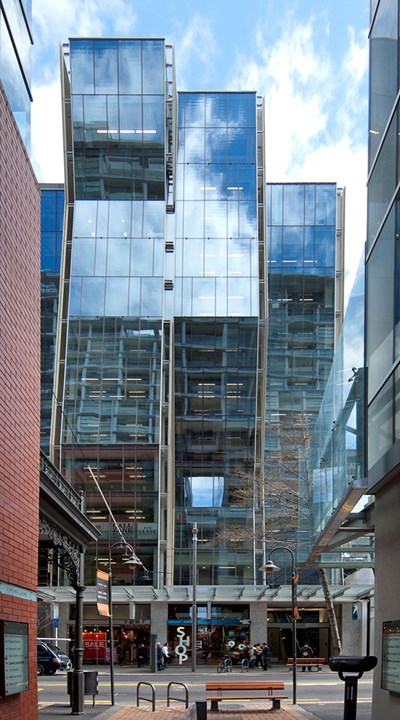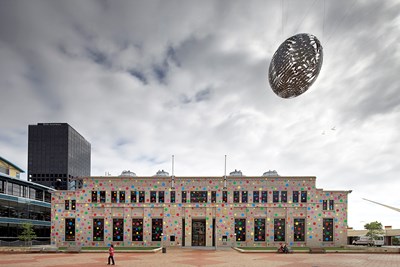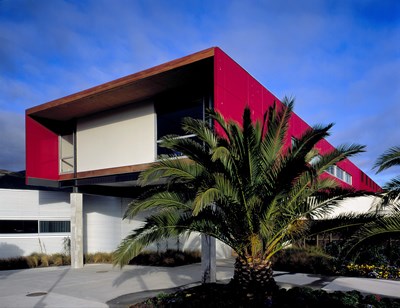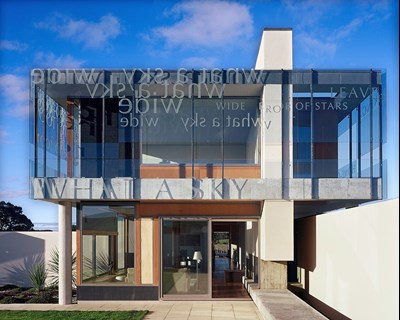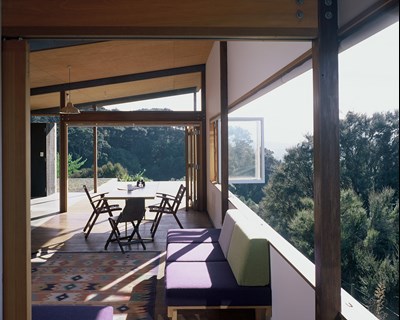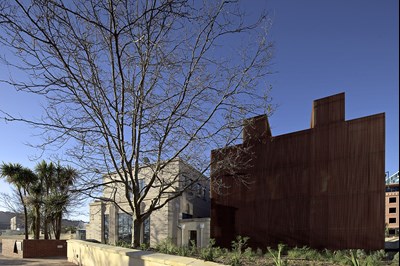2015 Gold Medal: Stuart Gardyne
Stuart Gardyne, at Tiratora, his family home, in Wellington
Photo by Simon Wilson
Stuart Gardyne is a fine architect whose professional ability and personal qualities have combined to produce a career of substantial achievement.
Throughout that career Stuart has exhibited persistence and commitment, openness and sensitivity, and an impressive determination to keep growing as an architect. In Stuart’s case a courteous and thoughtful manner drapes a flinty core; although his ambition might be under wraps and he eschews overt self-promotion, at key junctions in his life this careful person has made brave choices which have enabled him to make his mark on the city he knows so well.
It’s easy to make retrospective sense of a life and career but certain professional motifs have been consistently present in Stuart’s practice, and some personal traits have guided his progress. There is a sense that Stuart has paced his career and paid his dues – his architectural development has been purposeful and thoroughly deserved. Right from the start, Stuart exhibited a willingness to get hands-on experience of the business of realising design.
After he graduated, he chose to work for the large and not-so-fashionable Structon Group because the firm did a lot of commercial work and therefore offered valuable lessons in the realpolitik of architecture.
The time at Structon gave Stuart a strong professional base, and opportunities to develop ideas and design beliefs about the use and occupation of buildings, and workplace organisation, that later informed acclaimed projects such as Conservation House and Spark Central undertaken by his own practice, architecture+.
To an unusual extent Stuart has been able to synthesise work across genres. He takes as much care over commercial projects as he does over residential and public commissions. That is because he focuses on the people who work, inhabit or visit buildings. Stuart’s people-centric design is complemented by the pleasure he takes in figuring out the plan and the effort he makes to make the most of the brief. These qualities are evident in residential projects such as Morrison’s Bush Cabin and Ponatahi House in the Wairarapa, and his own house in Wellington, which for thirty years – in the best tradition of the architect’s own house – has served as a palimpsest of an architectural life. The qualities, as well as an informed appreciation of typology, are expressed in public buildings such as Pataka-Porirua Museum of Arts and Culture, Expressions theatre and art gallery in Upper Hutt, and City Gallery, Wellington.
It is at City Gallery, perhaps the project closest to Stuart’s heart and probably the most important to his career (it launched his firm, architecture+), that the architect’s dextrous handling of interiors and increasingly confident treatment of form are most clearly on display.
In two stages, with a third to come, Stuart has turned a public library into a vibrant public art gallery in a manner both robust and respectful. City Gallery, together with small urban interventions such as the Street Corner Canopies, and prominent buildings such as the waterfront Te Wharewaka o Poneke-Te Raukura, declares Stuart’s arrival on the public stage in Wellington. He has become a place maker, and his city is profiting from his understanding of its people and its patterns, his sympathy for cultural aspirations and his knowledge of commercial realities, his willingness to test a brief and his eagerness to challenge himself. Stuart has become an architectural leader as well as an excellent designer, and the profession he so admirably represents has benefited enormously from his collegiality, intelligence and integrity. For all these reasons Stuart Gardyne is a most worthy recipient of the New Zealand Institute of Architects Gold Medal.
Download a pdf of Stuart Gardyne's Gold Medal book.

To an unusual extent Stuart has been able to synthesise work across genres. He takes as much care over commercial projects as he does over residential and public commissions. That is because he focuses on the people who work, inhabit or visit buildings. Stuart’s people-centric design is complemented by the pleasure he takes in figuring out the plan and the effort he makes to make the most of the brief. These qualities are evident in residential projects such as Morrison’s Bush Cabin and Ponatahi House in the Wairarapa, and his own house in Wellington, which for thirty years – in the best tradition of the architect’s own house – has served as a palimpsest of an architectural life. The qualities, as well as an informed appreciation of typology, are expressed in public buildings such as Pataka-Porirua Museum of Arts and Culture, Expressions theatre and art gallery in Upper Hutt, and City Gallery, Wellington.
It is at City Gallery, perhaps the project closest to Stuart’s heart and probably the most important to his career (it launched his firm, architecture+), that the architect’s dextrous handling of interiors and increasingly confident treatment of form are most clearly on display.
In two stages, with a third to come, Stuart has turned a public library into a vibrant public art gallery in a manner both robust and respectful. City Gallery, together with small urban interventions such as the Street Corner Canopies, and prominent buildings such as the waterfront Te Wharewaka o Poneke-Te Raukura, declares Stuart’s arrival on the public stage in Wellington. He has become a place maker, and his city is profiting from his understanding of its people and its patterns, his sympathy for cultural aspirations and his knowledge of commercial realities, his willingness to test a brief and his eagerness to challenge himself. Stuart has become an architectural leader as well as an excellent designer, and the profession he so admirably represents has benefited enormously from his collegiality, intelligence and integrity. For all these reasons Stuart Gardyne is a most worthy recipient of the New Zealand Institute of Architects’ Gold Medal.




